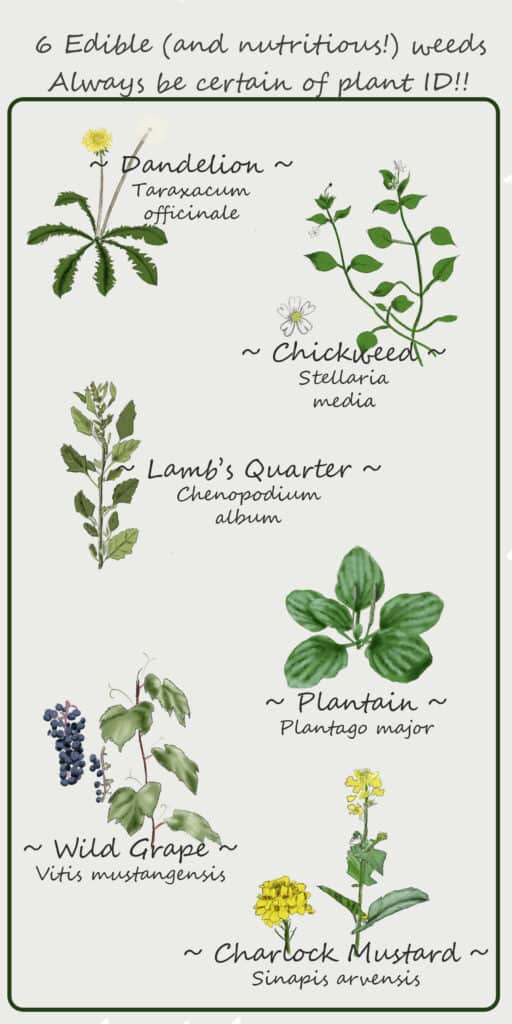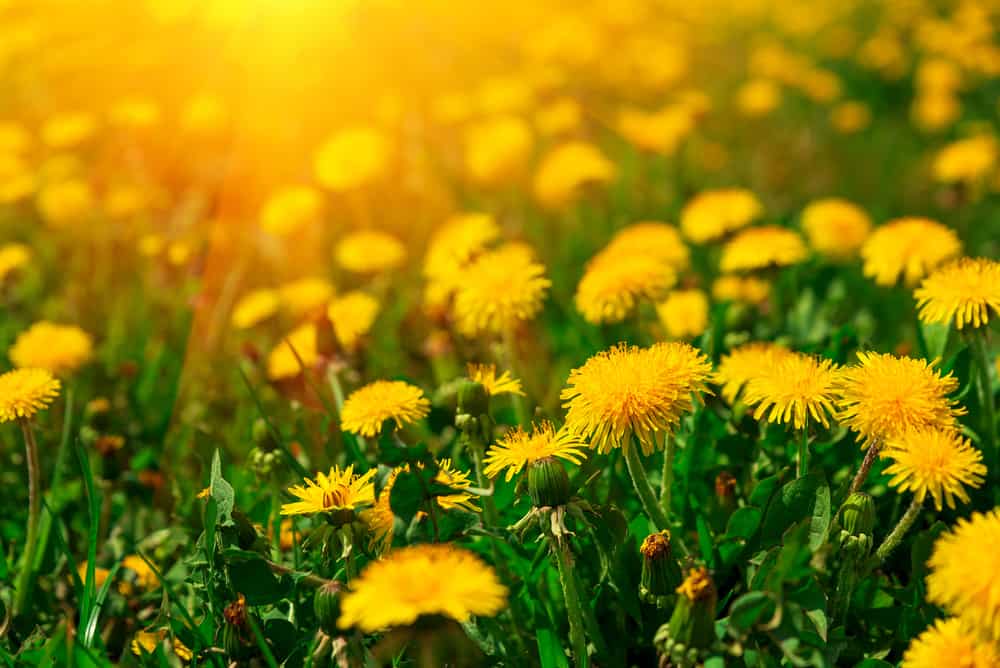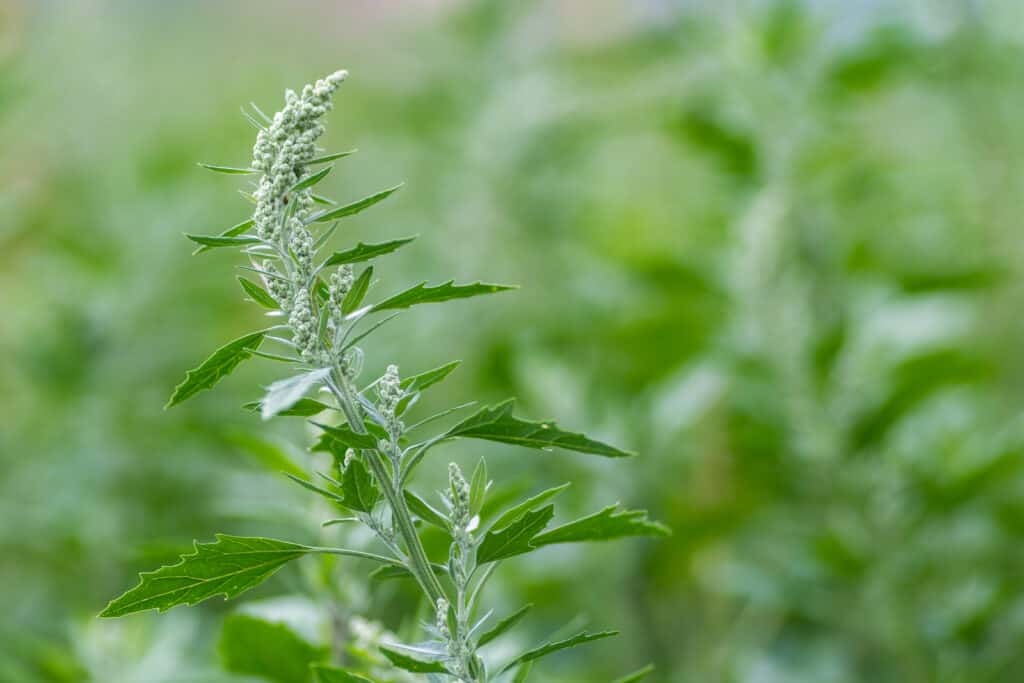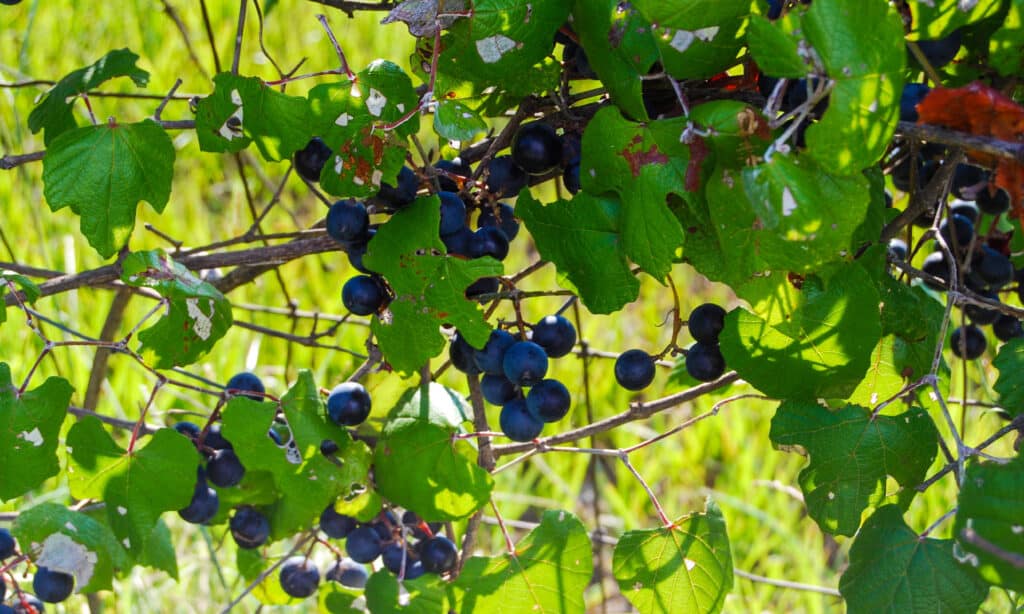Chickweed, dandelion, and mustard may seem like noxious weeds in your garden, but did you know that they — and many other “weeds” — are edible? Not only that, they are tasty! If you learn to identify them accurately, you can also find them while hiking or camping. These six are common and easy to identify.

A word of caution: Before eating anything you harvest, be 150% positive of its identity. Also, some people use most of these medicinally, but before you do that, check with your doctor.
Dandelion (Taraxacum officinale)

This dandelion (
Taraxacum officinale) grows in most temperate areas of the world.
©Tetiana Shumbasova/Shutterstock.com
Their bright yellow flowers and “poof ball” seed heads are unmistakable harbingers of spring that pop up in the most inconvenient locations, like the beautiful green lawn you’ve tried so hard to cultivate or the cracks in the sidewalk. Well, instead of yanking them up by the root, consider this: gourmet stores sell dandelion greens at outrageous prices. So why not enjoy some of nature’s bounty for free?
How To Identify Dandelions
Of course, there’s a catch because dandelions have a few lookalikes in North America. The good news is that none of the lookalikes are dangerous, and in fact, they’re all edible and considered by some to be medicinal. Chicory (Chicorium intybus), Cat’s ear species (Hypochoeri spp.), annual sowthistle (Sonchus oleraceus), and shepherd’s purse (Capsella bursa-pastoris) have all been mistaken for dandelion.
However, identifying it couldn’t be easier because dandelion always has these traits:
- The stem is hollow and has milky sap inside.
- There are no hairs on the leaves or stems.
- There’s always only one flower on the stalk.
- The teeth on the leaves are highly variable, but they always point toward the center of the plant.
Where Do Dandelions Grow?
There are hundreds of species in the Taraxacum genus, but we are only discussing the common dandelion (Taraxacum officinale) for this article.
This dandelion grows in most temperate areas of the world. It prefers moist soil where its taproot can grow more quickly. You’ll find dandelions along roadsides, growing in lawns, and along forest trails where they can get enough sun. They flower from about May through August, depending upon the weather. Flowers turn into white poof balls full of seeds with little umbrellas attached.
Unlock Dandelion’s Delicious Benefits
Most parts of the dandelion are edible, tasty, and full of nutrition. You can eat the root, leaves, and flowers; however, the leaves are more bitter after the plant flowers. Dandelion greens are great raw or cooked and contain vitamins A, C, E, B, and folate. They also include several minerals, such as calcium, magnesium, potassium, and iron.
The roots contain inulin, a type of soluble fiber that is good for your gut. Of course, you can cook them just like any other root vegetable.
Some people use dandelion as a health supplement to support the kidneys, liver, and blood sugar; however, you should always consult your doctor before taking any supplement.
However, I recommend avoiding the flower stalks and green around the flowers — they don’t taste good. In addition, the milky sap contains latex, so if you’re sensitive to latex, you’ll want to wear gloves while harvesting.
Chickweed (Stellaria media)

Chickweed grows into beautiful thick mats and is a lovely accent in a spring garden.
©iStock.com/Stefan Rotter
Spring salads wouldn’t be the same without chickweed. It grows into beautiful thick mats and is a lovely accent in a spring garden. I prefer chickweed raw, but it’s also enjoyed as a cooked green. Like many plants, there are dozens of species in the genus Stellaria; however, we only eat a few.
How To Identify Chickweed and Watch Out for Scarlet Pimpernel
Correctly identifying chickweed is essential because it does have a look-alike. If you think you’ve found chickweed, take a closer look:
| Chickweed | Scarlet Pimpernel |
|---|---|
| Chickweed has stringy stems with a single line of hairs going up the stem. | Scarlet pimpernel has square stems. |
| Small oval leaves often come to a point. | Oval leaves with black dots on the underside. |
| White five-petaled with deep lobes that make it look like 10 petals. | Red or bluish-red flowers with five petals that are only open when there’s enough sunlight. |
| Branches out a lot near the base of the plant. | Branches out from the base of the plant. |
| Tastes good. | Tastes awful. |
Scarlet Pimpernel (Anagallis arvensis) can grow intertwined with chickweed, so be careful harvesting and be 150% positive of your identification. The leaves are technically edible, but they taste awful. In addition, it can cause stomach upset if you eat too much of it at one time.
Where Does Chickweed Grow?
A European native, chickweed is naturalized throughout most of the Northern Hemisphere. It prefers rich garden soil, but I have also seen it grow in awful clay soil. It prefers open areas like meadows, lawns, and the edges of agricultural fields.
Making Use of Chickweed’s Delicious Benefits
Chickweed is high in several minerals and vitamins, including vitamin C, iron, potassium, and zinc. In addition, it contains mucilaginous compounds that can help soothe the throat and stomach. A 2020 study determined it contains antifungal, antibacterial, antioxidant, and anti-inflammatory properties.
However, far from being just a nutritious weed, chickweed is also delicious. Its somewhat subtle flavor pairs nicely with salads. Many people describe it as being similar in flavor to cornsilk. My favorite way to enjoy chickweed is fresh off the plant. It’s a wonderful snack while I’m out gardening.
Lamb’s Quarter (Chenopodium spp.)

They’re collectively known as goosefoots and have been in culinary use for over 5,000 years.
©Arkadiusz Kolos/Shutterstock.com
This yummy wild plant is in the same genus as quinoa! The seeds and aerial parts of the plant are edible and delicious. They’re collectively known as goosefoots and have been in culinary use for over 5,000 years.
At one point, scientists believed that it was a European native that made its way to the New World. However, newer data shows that many species of goosefoots are native to different parts of the world. For example, in Europe, you’re most likely dealing with white goosefoot (C. album), while North Americans most likely have pitseed goosefoot (C. berlandieri). In Mexico and Central America, quinoa (C. quinoa) is more common; to further complicate things, there are several dozen goosefoots worldwide.
How To Identify Lamb’s Quarter
Lamb’s quarter is a member of the Amaranthaceae family. It is herbaceous, meaning it doesn’t form a trunk like a tree (oddly, banana plants are giant herbs!). As the plant grows, it branches off many times, and some species can reach seven feet tall.
Here are a few defining characteristics:
- The leaves have a white substance that feels waxy or powdery. It rubs off easily and is more concentrated at the base of new leaves.
- Its leaves are roughly oval with pointed tips and teeth along the edges. They look jagged and sometimes resemble a goose’s foot in shape.
- The stems are thick and ribbed; they range in color from reddish purple to silvery green.
- They flower but not with petals — they look like tiny cauliflowers.
Watch Out for Look-alikes
I do not feel that these look at all like lamb’s quarter. When you see a photo of them side-by-side, there’s no doubt which one is lamb’s quarter.
However, because some people have mistaken black nightshade (Solanum nigrum) for lamb’s quarter, I’m including the information so you can be safe. Deadly nightshade (Atropa belladonna) is a look-alike for black nightshade, so as always, be absolutely positive that your identification is correct.
| Lamb’s Quarter | Nightshades |
|---|---|
| Leaves have a white powdery substance that rubs off easily. It’s more concentrated at the base of new leaves and the underside of leaves. | Produces berries |
| Leaves are oval with jagged teeth, sometimes resembling the shape of a goose’s foot. | Smoother egg-shaped leaves |
| No actual flowers! They’re inflorescences with no petals. | Flower with actual petals, which are pretty. |
| Produces up to 72,000 seeds on a single plant but no berries. |
Where Do Lamb’s Quarters Grow?
There are different types of lamb’s quarters worldwide, even a few native species in Australia. Chenopodium spp. are opportunistic and will grow anywhere there’s adequate sun and moisture. Many species are relatively drought-tolerant.
They begin to sprout in the spring, which I often help make happen because I gather seeds and make sure that the native variety spreads.
Unlocking Lamb’s Quarters’ Delicious Benefits
If you collect enough of its tiny seeds, you can grind it into flour to make bread — or you can cook and eat them like quinoa. Moreover, the leaves themselves are a powerhouse of nutrition. According to WeightChart.com, within one cup of chopped lamb’s quarter, you’ll find an astounding number of nutrients, including vitamins A, B6, B12, C, D, and K, Calcium, Iron, Magnesium, Phosphorus, Zinc, Copper, Manganese, Selenium, Thiamine, Riboflavin, Niacin, Folate, and a little Choline.
Lamb’s quarter is best as a cooked green. Like pineapple, eating too much of the herb’s raw greens can burn your mouth, but cooking breaks it down. So I use it anywhere I would use cooked spinach, such as in soups, stews, with other greens, and by itself, like collard greens. One of my family’s favorites is our version of spinach and artichoke dip. Another is lamb’s quarter cooked with a little olive oil, butter, and garlic and served as a side.
Plantain (Plantago spp.)

While it shares its common name with the banana-like fruit, it isn’t a banana.
©pisitpong2017/Shutterstock.com
Like many others, people overlook this plant and treat it like a pest. However, it’s one of the best home remedies for bee stings, soothes rashes, and is entirely edible.
While it shares its common name with the banana-like fruit, it isn’t a banana. Instead, it’s a small herbaceous plant in a genus with over 200 members. In addition, there are species native to various parts of the world. Still, for this article, I’m focusing primarily on the species most commonly spotted in Europe and North America — broad-leaf plantain (Plantago major).
How To Identify Plantain
Plantain is a herbaceous perennial that grows as a rosette of leaves 6-12 inches across. Its leaves are oval-shaped, up to eight inches long, and three inches across. Each leaf has between five and nine distinctive veins that extend over the leaf’s length.
When they flower, it’s in a single flower spike that comes up from the plant’s center. Plantains do have flowers, but they’re very small and difficult to see on the spike. The seeds stick to every bit of fur and fabric that they touch. They’re native to Europe and Asia and made their way here with European settlers. No one is certain whether they came with the animals or the people, but whichever the case, they earned the nickname “White man’s footsteps” because they seemed to appear wherever Europeans traveled.
Plantain Look-Alikes?
The only plants that remotely resemble are those of the Erigeron genus, but only if you squint at it just right and if it doesn’t have any flowers.
| Broad-leaf Plantain | Erigeron spp. |
|---|---|
| Wide, smooth-edged, oval-shaped leaves. | Leaves are lightly serrated on the edges. |
| Tiny flowers on leafless spikes. | Daisy-like flowers that have leaves on the stem. |
| Seeds that grab anything and travel. | Seeds develop in the seedhead, similar to a sunflower. |
Where Does Plantain Grow?
Like the goosefoots, there are native plantain species worldwide. Most of them are native to Europe and Asia, but there are a few in North America too. Broad-leaf plantain seems to be nearly everywhere I’ve ever been in the United States, from California to Georgia and North Carolina.
Unlocking Plantain’s Wild Goodness
Plantain tastes best in salads when the leaves are young and tender. However, as the leaves age, they become tough and stringy; they’re a great cooked green. They’re rich in calcium, and vitamin K, among others.
In addition to being a delicious green, it tends to be my favorite for insect bites. I live in Texas, where the mosquitos are big enough to carry off small children, so the bites are correspondingly big. I smash it into a paste and smear it on nastier bites, but I also use it for burns. A study published in 2017 reviewed the medicinal benefits of Plantago major published from 1937-2015 said, “Correspondingly, studies have found that Plantago major is effective as a wound healer, as well as an antiulcerative, antidiabetic, antidiarrhoeal, anti-inflammatory, antinociceptive, antibacterial, and antiviral agent.”
Mustang Grapes (Vitis mustangensis)

The mustang grape is the most common wild species in the eastern United States.
©CatherineTheGreat/Shutterstock.com
Grapes anyone? Wild grapes of several species within the genus Vitis grow worldwide. Here, we’re looking at Vitis mustangensis, known as mustang grapes. It’s the most common wild species in the eastern United States. Other regions in the world have predominant species – in the eastern United States, Riverbank grapes (V. riparia) are common, and there are other species in the west.
How to Identify Mustang Grapes
There are nearly 80 species in the genus Vitis, and even some of the varieties we cultivate for wine require rootstock from wild types. Take the time to find a guidebook for your area so you can confidently identify the local grape species.
Mustang grapes have lobed or heart-shaped leaves with a white underside and feel velvety or fuzzy. They’re coarsely toothed or serrated and can reach almost eight inches across. They produce inflorescences that turn into bunches of deep purple grapes, which are often bland to tart.
Avoid the Look-Alike
Canadian moonseed is the only plant that resembles mustang grapes, and the fruit is toxic. The easiest way to tell the difference is to check the fruit: moonseed has crescent-shaped seeds instead of the oblong seeds of a grape. Always be sure of your plant ID.
| Mustang Grapes | Canadian moonseed |
|---|---|
| (Vitis mustangensis) | (Menispermum canadensis) |
| Lobed or heart-shaped leaves with serrated edges grow on alternating sides of the vine. | Lobed leaves with few serrations. |
| Leaves have fuzzy white undersides. | |
| Forked tendrils that grab onto structures. | No tendrils. |
| Deep purple fruit that grows in large bunches. | Purple fruit that grows in smaller clusters. |
| The oblong seed inside the fruit is typical of grapes. | Purple fruit has crescent-shaped seeds inside. |
Where Do Mustang Grapes Grow?
These are prevalent in the south, from the eastern half of Texas through states like Alabama, Georgia, Arkansas, Louisiana, Oklahoma, Mississippi, and Texas. They grow anywhere there’s enough moisture in the ground and climb up virtually anything, just like other vines.
Unlocking Mustang Grapes’ Goodness
Mustang grapes are best cooked into pies, jams, grape juice, or made into wine. Young leaves are delicious when used as a wrap for fun fillings and baked like Greek dolmas, and aren’t sour like the pickled leaves most of us have to use.
The grapes and leaves are nutritious, and sources of vitamin C, and the grapes have a smattering of other nutrients like vitamin A and potassium too.
Charlock Mustard (Sinapis arvensis or Brassica kaber)

The great part about wild mustards is that they’re all edible but with different flavor profiles.
©aga7ta/Shutterstock.com
This mustard goes by many names — wild mustard, field mustard, wild kale, corn mustard, and others. Funny thing is that it’s in the Brassicaceae family with its more famous cousins kale, cauliflower, Brussels sprouts, and any other cabbage, so has many of the same characteristics. Those mustard greens in the store? You guessed it; those are charlock’s domesticated cousins.
How To Identify Charlock Mustard
There are around 3,000 species, and some of them cross-pollinate with one another. The vast number of different species makes it extremely difficult to determine which one you have. The great part about wild mustards is that they’re all edible but with different flavor profiles.
Charlock flowers in clusters of small, bright yellow flowers with four petals arranged in a cross formation. The clusters elongate as the seedpods grow.
The lower leaves usually have stalks and deep lobes with a big segment at the end and smaller lobes toward the base. Upper leaves typically don’t have stalks or separate lobes, but have coarse teeth. They usually have stiff hairs that point downward, especially on the lower parts. They’re green but can be somewhat purplish.
Cornell University has an amazing mustard ID page with a flow chart that helps you narrow down which mustard is in front of you.
The Look-alikes Are Probably Mustard Too
I wasn’t able to find information on dangerous look-alikes. However, because there are so many mustard species, even if it’s not charlock, there’s a good chance it is mustard.
Where Does Charlock Mustard Grow?
Wild mustard is native to Europe but quickly becomes invasive in other areas; this plant even grows in the Arctic Circle. It grows in fields, along the roadside, and at the edges of forests. If you find the plant in the United States, you’re probably doing the environment a favor by taking it. Of course, follow local laws for foraging and as permission on private property.
Unlocking Delicious Rewards With Charlock Mustard
These greens tend to be tougher, even when young. They’re so easy to use in soups and stews or mixed with other cooked greens. They come up in the spring, but sometimes you’ll see a second crop in the fall. We love them sauteed in butter and garlic with a little salt and pepper.
One Final Reminder
Foraging for wild edible plants is a fun hobby that is satisfying at the same time. However, because many plants have similar characteristics, it’s essential for your safety that you have a 150% positive identification for any plant you intend to eat.
Also, our bodies aren’t accustomed to wild plants’ often robust nutritive content. The cultivated varieties are weak in comparison. It’s best to start with smaller amounts and allow your body to adjust. You may experience GI upset while your body adapts even from very safe wild plants.
Here’s a handy graphic of all six wonderful wild plants I described:
The photo featured at the top of this post is ©
Thank you for reading! Have some feedback for us? Contact the AZ Animals editorial team.






